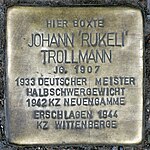Johann Wilhelm Trollmann
| Rukeli Trollmann |
|
|---|---|
|
Johann Wilhelm Trollmann, 1928 |
|
| Data | |
| Birth Name | Johann Wilhelm Trollmann |
| Weight class | Light heavyweight |
| nationality |
|
| birthday | December 27, 1907 |
| place of birth | Wilsche near Gifhorn |
| Date of death | 1944 |
| Place of death | Wittenberge (Brandenburg) |
| Combat Statistics | |
| Struggles | 62 |
| Victories | 30th |
| Knockout victories | 11 |
| Defeats | 19th |
| draw | 13 |
Johann Wilhelm "Rukeli" Trollmann (born December 27, 1907 in Wilsche near Gifhorn ; † 1944 in the Wittenberge subcamp of the Neuengamme concentration camp ) was a German boxer . As a Sinto , he became a victim of the Porajmos .
Life
German championship title - revoked
In February 1933, the Jewish boxer Erich Seelig won the middleweight title. The Association of German Professional Boxers then recognized him from the title.
So the title was vacant until June. On June 9, 1933 Trollmann fought against Adolf Witt . The chairman of the Association of German Pugilists (Radamm) was in the audience. When it became clear how the fight was going to end, he instructed the judges to classify the fight as "a draw". The judges followed this instruction. But the audience saw Johann Rukeli Trollmann as a far superior boxer. The outrage of the audience ensured that the winner was proclaimed as such.
Trollmann defeated his opponent, who he was superior to in terms of technique, mobility and, because of his only 71 kilos, especially in speed. (The fight between the two of them in the previous year ended in a draw or after points over eight rounds, which Trollmann lost.)
Eight days later, however, the title was revoked because of “poor behavior” (probably on the pretext of Trollmann's tears of joy after the victory).
Fight against Gustav Eder
Trollmann's fighting style, which showed similarities with the later style of Muhammad Ali , aroused displeasure during the Nazi era . In July 1933, two outstanding German boxers of their weight classes met in the Kreuzberger Bockbierbrauerei in Berlin : Gustav Eder in the welterweight division and his opponent Trollmann in the middleweight division . In the fight between the two boxers for the German welterweight title, Eder - nine centimeters shorter and six kilos lighter than his opponent - was supposed to repeat what Trollmann had achieved a few months earlier against the larger and heavier boxer Witt, namely a victory. The two boxers and their fight were instrumentalized in order to underpin the thesis of the rulers, the superiority of the " Aryan master race ". Trollmann came into the ring with dyed blond hair and his skin covered with white powder as a caricature of an "Aryan" boxer. Conditions were imposed on him that severely restricted his manner of fighting. Under threat of revocation of his boxing license, he was forbidden to fight his typical style, to offer the opponent no target and to counter-counter. He was also not allowed to make use of his range advantage and not box at a distance. The argument between the two pugilists turned into a farce. Trollmann did not move during the fight, but instead, standing with his legs apart, without crouching, took the blows of the opponent. He lost after five rounds through knockout. Trollmann then only kept his boxing license for a few months, the fight against Gustav Eder thus ended his boxing career.
Briefing in the workhouse
On June 1, 1935, Rukeli married his girlfriend Olga Frieda Bilda at the Berlin-Charlottenburg registry office, with whom he had had their daughter Rita since March 1935. A few weeks after the wedding, the director of the Berlin work and preservation house applied for the sterilization of Johann Trollmann, which was received by the district court on July 3, 1935. Trollmann's statements in court were used against him and to reinforce the "diagnosis" of "innate nonsense". Trollmann was probably forcibly sterilized on December 23, 1935.
Last years and death
During the Second World War he was drafted into the Wehrmacht and served as a soldier. He was injured on the Eastern Front and came back home.
In June 1942 Johann "Rukeli" Trollmann was arrested and taken to the Neuengamme concentration camp, where he was declared dead on February 9, 1944. According to a fellow inmate, he was sent to the Wittenberge satellite camp under a different name. There his boxing skills were his undoing, as he was beaten up again and again by SS people with reference to his boxing career. In 1944 a Kapo competed against Trollmann and was knocked down. The kapo was so angry that he took a club and killed Trollmann.
Late recognition
For the print media and functionaries of the boxing associations, withdrawing the championship title was not an issue after the Nazi era .
It was not until Hans Firzlaff published a book on the fate of Trollmann in the late 1990s that this question became a matter of general interest. In 2003, Trollmann was officially accepted as the German light heavyweight champion by the Bund Deutscher Berufsboxer eV (BDB) in the “squad of German champions”. However, the BDB refused to symbolically hand over a master belt to his relatives Louis and Manuel Trollmann, who were still alive. Thereupon the manager and matchmaker Olaf Schröder and the promoter Eva Rolle made a belt at their own expense, which the Trollmann family then bought on December 18, 2003 as part of a small boxing event in Berlin in the presence of the chairman of the Central Council of Sinti and Roma, Romani Rose , and was presented to a number of Holocaust survivors.
Commemoration
- Stumbling blocks for Rukeli
- In 2004, in the Kreuzkirchenviertel in Hanover's old town , the small Tiefental footpath between the Kreuzkirche and Burgstraße was renamed Johann-Trollmann-Weg. In 2008 a stumbling block was laid for him in front of his former home . In May 2009, a stumbling block in memory of Trollmann was laid in front of the Rote Flora portal in Hamburg's Schanzenviertel . He had - most recently in November 1933 - played some of his professional boxing matches in the historic Flora Theater. In July 2010, another stumbling block was laid in Fidicinstrasse in front of the former Bock beer brewery in Berlin-Kreuzberg , where Trollmann had fought against Witt and Eder.
- Stumbling block for Stabeli
- Trollmann's brother Heinrich, called Stabeli, was murdered in 1944 in Auschwitz concentration camp at the age of 27. For him, too, there is a stumbling block in the Johann-Trollmann-Weg in Hanover.
- Johann Trollmann Boxing Camp in Berlin
- On January 28, 2011 in Berlin-Kreuzberg, the sports hall of the former Rosegger elementary school on Marheinekeplatz was named Johann Trollmann Boxing Camp .
- Temporary memorial
- The artist collective Movement Nurr initiated a project “9841 - Temporary Monument for Johann Rukeli Trollmann”, which consists of a boxing ring with an inclined fighting surface. The number 9841 is Trollmann's prisoner number . The sculpture was set up in Berlin in 2010, in Hanover in 2011, not far from his previous residence for about six weeks and since 2012 in Dresden Hellerau.
- Play "The Boxer"
- On January 29, 2015, the play "Der Boxer" by the Austrian author Felix Mitterer was premiered in the Theater in der Josefstadt in Vienna. The plot of the play is "freely based on the fate of the Sinto boxer Johann 'Rukeli' Trollmann", the main role was given to the Austrian actor Gregor Bloéb , directed by Stephanie Mohr .
- Plaque
- In February 2020 , a memorial plaque was unveiled at the former Bockbierbrauerei, Berlin-Kreuzberg , Fidicinstraße 2 .
Stumbling block for Johann Trollmann in Hamburg
Stumbling block for Johann Trollmann in Berlin-Kreuzberg
Inauguration of the art group movement Nurr temporarily erected sculpture of an oblique boxing ring for Johann Trollmann on the Ballhof place in Hannover
Memorial plaque in front of the former Bock beer brewery in Berlin-Kreuzberg
See also
literature
- Hans Firzlaff: Knock-out: the life of the German Sinti boxer Rukelie Trollmann from Hanover's old town. 2nd Edition. Satire-Verlag, Hanover 1997, ISBN 3-923127-23-6
- Marko D. Knudsen: History of the Roma. RomaBooks.com, Hamburg 2002.
- Knud Kohr, Martin Krauß: Kampftage - The history of the German professional boxing. Verlag die Werkstatt, Göttingen 2000, ISBN 3-89533-309-3 .
- Michail Krausnick : Where did you get to? The suppressed genocide of the Sinti and Roma. Bleicher, Gerlingen 1995, ISBN 3-88350-038-0 , pp. 73-79.
- Roger Repplinger: Lie down, gypsies. The story of Johann Trollmann and Tull Harder . Piper, Munich 2008, ISBN 978-3-492-04902-3 .
- Claus Grote: Johann Wilhelm Trollmann, called Rukelie, called Gipsy. An outsider biography in German boxing. In: A. Krüger, B. Wedemeyer (Hrsg.): Learn sports history from biographies. Hoya 2000, ISBN 3-932423-07-0 , pp. 177-199.
Fiction
- Stephanie Bart : German champion . Novel. Hoffmann and Campe, Hamburg 2014, ISBN 978-3-455-40495-1 .
Movie
- Rukelie , Germany 2007; Director: Sabine Neumann, leading actors: Stanislav Lisnic, Nora von Waldstätten, length: 11 min.
- Gibsy - The story of the boxer Johann Rukeli Trollmann , docudrama Germany 2012. Script and direction: Eike Besunden , leading actors: Hannes Wegener , Hannelore Elsner .
theatre
- Björn Bicker, Marc Prätsch: Trollmanns Fight - Mer Zikrales. World premiere at schauspiel hannover April 30, 2010, director: Marc Prätsch
- Rike Reiniger : Gypsy Boxer , world premiere at Staatstheater Karlsruhe, October 23, 2011, director: Frederik Tiden
- Felix Mitterer : The Boxer , world premiere at Theater in der Josefstadt , Vienna, January 29, 2015
Web links
- Website of the family of the Boxer Trollmann with photos
- Website of the Rukeli Trollmann eV association
- Memory of a murdered boxer: Johann-Trollmann-Weg
- Trollmann article in the Boxrec Boxing Encyclopaedia-Wiki of BoxRec.com (Boxing Records Archive; engl.)
- Johann Wilhelm Trollmann in the BoxRec database
- Trollmann Info on the temporary Trollmann memorial
Individual evidence
- ↑ http://boxrec.com/en/title/314/Light%20Heavyweight?offset=50
- ↑ http://www.rukeli-trollmann.de/lebenslauf-johann-rukeli-trollmann/
- ^ Bernhard Bremberger, Lothar Eberhardt: 195 Forced sterilization from the Berlin work and preservation house in Rummelsburg
- ↑ Martin Sonnleitner: The striker and the driver. In: Spiegel Online. June 17, 2008.
- ↑ The Torments of a Boxer. In: Hamburger Abendblatt. February 14, 2009.
- ↑ a b Patrick Hoffmann: 13 more stumbling blocks laid. In: Hannoversche Allgemeine Zeitung. March 23, 2010, p. 15.
- ^ Website for project 9841
- ↑ josefstadt.org
- ^ Newspaper report on the world premiere of Trollmanns Kampf in the HAZ on May 2, 2010.
- ↑ Ignorantly violated all taboos. In: taz . April 28, 2010.
- ↑ The boxer. ( Memento from December 7, 2015 in the Internet Archive )
| personal data | |
|---|---|
| SURNAME | Trollmann, Johann Wilhelm |
| ALTERNATIVE NAMES | Trollmann, Ruckeli (nickname) |
| BRIEF DESCRIPTION | German boxer |
| DATE OF BIRTH | December 27, 1907 |
| PLACE OF BIRTH | Wilsche |
| DATE OF DEATH | 1944 |
| Place of death | Wittenberge concentration camp |








